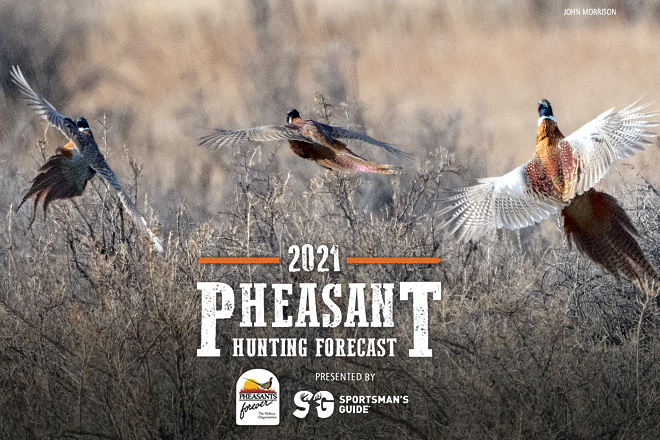
Pheasant hunting opportunity and access should be about the same as 2020 in Kansas, meaning a pretty good hunting season
By David Zumbaugh
My earliest boyhood memories are of my father returning from bird hunting trips. He would bring home a Styrofoam-lined, waxed cardboard box packed with dressed pheasants. The colorful heads remained to verify they were roosters.
My wife believes this traumatic visual experience spawned an obsession with dogs and ringnecks for me. This Upland Forecast is not a secret map plastered with “X’s” directing you easy bag limits. It is a prioritized outline for you to find accessible habitat, burn some boot leather, and have realistic chances at finding collectable tail-feathers.
"In Kansas, the second Saturday in November is a hallowed date for hunters, who like me, have never fully recovered from the adrenaline rush of that first rooster pheasant flushing at our feet," said Mike Miller, assistant secretary of Operations for the Kansas Department of Wildlife and Parks (KDW&P). "Kansas offers the perfect bird-hunting get-away with long seasons, generous bag limits and more than one million acres of Walk-in Hunting Access (WIHA). During the chaos of this pandemic, we invite you to practice social distancing on our wide-open fields and prairies where you’ll find pheasants, quail and an escape to normalcy."
Jeff Prendergast of KDW&P said, “Roadside surveys slightly decreased from last year. However, conditions for the surveyors were not optimal. Production values were up overall. Pheasant hunting opportunity and access will be about the same as 2020.”
REGIONAL FIELD REPORTS
Northwest Kansas
Keith Hughes, local landowner says, “Ample spring rains led to lush growth of CRP, grasslands and pivot corners. A banner wheat crop added to optimism for good fall populations. Large hatches of pheasants have been observed and even some quail are being noticed this year. Standing corn and milo crops are looking decent and harvest waste grain will support birds through autumn and winter. Make sure you have foot protection for your canines, as sand burrs can be an issue.”
South Central/Flint Hills
Roger Wells, retired biologist offered, “Pheasants can be found in habitat near crop fields and wheat stubble if you put in some miles. Refer to the on-line WIHA access maps or OnX to save time.” Significant management efforts (burning, red cedar removal) generated habitat improvements for the Red Hills, Texas Lake and Pratt Sand Hills Wildlife Areas with outcomes yielding more pheasants. CRP and WIHA acres are actually increasing in some counties in this zone.
North Central Kansas
James Svaty, KDW&P biologist told me, “Timely spring moisture spawned excellent forb growth, initiating good nesting conditions, but it got hot and dry in July and August which will impact overall recruitment. Quail whistle counts were up, but pheasant broods were sketchy. WIHA and CRP access should be about the same as last year. Wildlife Management Areas around Wilson, Glenn Elder, Lovewell Lakes and Jamestown Wildlife Area will certainly hold pheasants and some quail.”
Southwest Kansas
Terrell Giddens, a Southern Baptist Pastor and avid bird hunter told me, “Unfortunately drought plagued Southwest Kansas in 2021. If you want to walk 20 miles and not stop for lunch you might get your limit on Walk-in Hunting Access (WIHA) and field borders. If you have access to irrigated plots, abandoned farmsteads, or playas you will have more success. Target small parcels of thick tumbleweed instead of wading into half sections of CRP or embarking on endless treks within the Cimarron National Grassland.” Be advised, porcupines exist in the riparian ecosystem adjacent to the Arkansas River.
Northeast Kansas
Historically, both pheasants and quail were abundant in this slice of Kansas. Pheasant habitat has waned with increased size of crop fields via removal of fence rows, leading to degraded field edges and less access. There is a draw hunt for pheasants at Benedictine Bottoms Wildlife Area and lucky nimrods with good dogs might be rewarded with a ringneck dinner. WIHAs north of Perry Lake and west should hold pheasants and quail for those willing to study maps and trek to snarly places devoid of human footprints.
Southeast Kansas
Traditionally, this part of the state was a quail hunting Mecca. There are still areas with optimum habitat where a long walk behind a favorite pointer could put birds in the vest and maybe even a ringneck.
Check the KDW&P website occasionally in the coming weeks to see when their official
Upland Bird Forecast 2021 publishes.